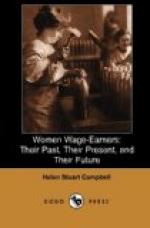Colorado followed, giving in the report for 1887 and 1888, under the management of Commissioner Rice, a chapter on women wage-workers, in which space is given to certified complaints of the women themselves, as to what they consider the disabilities of their special trades. Domestic service, with some of its abuses, was also considered, and is of much value. These reports sum up the work so far done in the West, where labor bureaus are of recent growth. The spirit of inquiry is, however, equally alive; and each year will see minuter detail and a deeper scientific spirit.
Maine, in the report for 1888, took up many questions of general interest, with their incidental bearings on the work of women; and in 1889 came another report from Kansas, in which the labor commissioner, Mr. Frank Betton, gave large space to an investigation conducted under many difficulties, but covering the ground very fully. A very full report from Michigan, under Commissioner Henry A. Robinson, was issued in 1892, nearly two hundred pages being given to an exhaustive examination into the conditions of women wage-earners in the State, its methods owing much to the work which had preceded it.
With this background of admirable work always, no matter what might be the limitations, making each report a little broader in purpose and minuter in detail, the way was plain for something even more comprehensive. This was furnished by the Bureau of Labor of the United States, which had changed its name, and become, in June, 1887, the Department of Labor, a part of the Department of the Interior. This report—the fourth from the bureau, and issued in 1888—was entitled “Working-Women in Large Cities,” and included investigations made in twenty-two cities, from Boston to San Francisco and San Jose.
All that long experience had demonstrated as most important in such work was brought to bear. The investigation covered manual labor in cities, excluding textile industries, save incidentally as these had already been treated, as well as domestic service. Textile factories are usually outside of large cities, and it was the object to discover the opportunities of employment in the way of manual labor in cities themselves.
Three hundred and forty-three distinct industries showed themselves, and others were found which were not included, it being safe to say that some four hundred may be considered open to women. As before stated, many are simply subdivisions, made by the constantly increasing complexity of machinery. The agents of the department carried their work into the lowest and worst places in the cities named, because in such places are to be found women who are struggling for a livelihood in most respectable callings,—living in them as a matter of necessity, since they cannot afford to live otherwise, but leaving them whenever wages are sufficient to admit of change.
It is this report which forms the summary of all the work that has preceded it, and that gives the truest exponent of all present conditions. It is only necessary to add to it the summaries of the State reports at other points, to see the aspect of the question as a whole; and thus we are ready to consider by its aid the general rates of wages and of the status of the trades of every nature in which women are now engaged.




